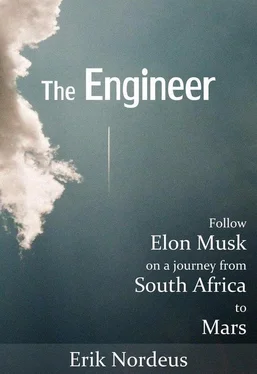Another supplier of parts to the rocket’s fuel tanks raised the price after delivering only a small amount of their products. They thought SpaceX didn’t have any other choice than to accept the higher price. The supplier was wrong and is no longer a supplier to SpaceX. “It was like a painter who paints half your house for one price, then wants three times that for the rest,” a SpaceXer said. “That didn’t make Elon too enthusiastic. He was like, ‘All right, we’re not going to get screwed by these guys.’“ 278
While Tesla named each conference room after failed electric car companies, SpaceX named each conference room after scientists, engineers, and astronauts related to the space industry. 453But Elon is generally not a fan of meetings. “Meetings are what happens when people aren’t working,” he said.
A conference room was named after the German Hermann Oberth, who is considered one of the founding fathers of rocketry and astronautics. Another founding father is the Russian Konstantin Tsiolkovsky, who also gave his name to a conference room.
Another conference room was named after the American Robert H. Goddard. He became an early American space pioneer and is considered a founding father of rocketry and astronautics. In an article from 1919, Goddard explained how a rocket could travel in the vacuum of space to the Moon. No one believed him. To prove his theories, Goddard attached a pistol to a spindle free to rotate inside a bell jar from which the air was evacuated. When Goddard fired a blank cartridge, the gun recoiled in the direction opposite to the escaping gases, and it proved that his theories were correct. In 1926, Goddard launched the first rocket propelled with liquid oxygen and gasoline. The rocket traveled to a height of 41 feet [13 m] and landed 184 feet [56 m] away in a cabbage patch. His team’s later rockets reached heights of 1.6 miles [2.6 km]. 132
A fourth conference room was named after Wernher von Braun, and there’s a portrait of him hanging in the entrance to the SpaceX factory. The German rocket engineer became interested in space when his mother gave him a telescope. At school, von Braun found the book Die Raketen zu den Planetenraumen [The Rocket into Planetary Space] by Hermann Oberth. “Its pages were a hash of mathematical formulas,” von Braun said. “It was gibberish. I rushed to my teachers. ‘How can I understand what this man is saying?’ I demanded. They told me to study mathematics and physics, my two worst courses.” When he realized that both mathematics and physics were important, he excelled in both subjects. With a degree in mechanical engineering, he began a secret doctoral dissertation for the German army. 131
During the Second World War, von Braun directed the development of the Aggregate series of rockets. If the war had not ended, the rockets would have ranged from A-1 to A-12, where the A-12 was designed to carry a 10 tonnes payload to low Earth orbit. The A-4 rocket was the first man-made object to reach space. But the Germans realized they could use the A-4 as a weapon. The well-known, notorious V2 rocket was born.
The V in V2 stands for Vergeltungswaffe [Retaliation weapon]. The first in the series was the V1 – a small, unmanned aircraft powered by a pulse-jet engine. Launched against England, the V1 was slow and thus easy to shoot down by British fighter pilots. The same fighter pilots realized that the V2 was impossible to intercept and destroy because it traveled at supersonic speeds. The first V2 crashed in west London in September 1944, killing three people and injuring seventeen. More than 3000 of these rockets were fired against London and other targets during the end of the war. 130
The German rocket technology was at least 25 years ahead of everyone else. US noticed that the Soviets were interested in these rockets, so to not get behind, they decided to capture as much rocket technology as possible. And since no one knew if the nuclear bomb would work, the V2 could be useful in the war against Japan, which at the time seemed far from over. Before the war in Europe ended, both American and Soviet troops tried to capture von Braun himself, his engineers, and his technology. 36
Soviet forces were the first to reach the German rocket center in Peenemünde. But it was empty. During the last months of the war, horror stories spread among German troops and civilians about what would happen to them if the Red Army captured them. To avoid this faith, they retreated west to be captured by mainly American and British forces. Von Braun was ordered to stay and fight. But he ignored the order and retreated west together with rockets, engineers, and documents containing his research. He would eventually be captured by American troops. 36
US initiated Operation Overcast – a program to acquire German technology and expertise. The decision to recruit German expertise was under many discussions, and the original plan was to intern them at a distant island. Von Braun was ranked as one of the scientists most adaptable to the American lifestyle, thus he, together with 350 German specialists, emigrated to the US. 131
Von Braun began working on the nuclear missile program that would eventually turn into a space program. As the Russians worked on their own nuclear missile, the race to build the largest rocket had begun. Both teams began with the basic V2 rocket. The two countries had competed in who could transport most rocket technology away from Germany. 92 trains headed for the Soviet Union, while the US took rockets and 14 tonnes of documents. The Soviets, however, didn’t find any blueprints. To draw new blueprints, they captured German engineers, deported them, and forced them to reproduce all the blueprints for the V2. It took two years. 36
Compared with his competitors across the globe, von Braun lived a better life in US, but would always be remembered of his German origin. He claimed that he wasn’t a Nazi and he had only joined the Nazi Party to be able to work on his rockets since civilian rocket tests were outlawed. “We felt no moral scruples about the possible use of our brainchild,” von Braun said. “We were interested solely in exploring outer space.” But it has been estimated that 7000 people died in V2 attacks, and 12 000 slave laborers died while building the rockets. 131
During one press conference, a journalist asked jokingly if von Braun’s new American rocket would land in London – a reference to the V2 rockets landing in London during the war. It made von Braun leave the room. Another common way to taunt von Braun was to talk about NASAism, a word similar to Nazism, and the satirist Tom Lehrer sang, “Once the rockets are up, who cares where they come down? ‘That’s not my department,’ says Wernher von Braun.” 15
The US rocket engineers lost against the Soviet Union in the race who could launch the first satellite. Von Braun was ready to launch a satellite on the top of his modified Jupiter-C rocket called Juno-1. But he wasn’t allowed to, mainly because of political reasons as he was from Germany. To prevent von Braun from launching a satellite by “accident,” Pentagon sent inspectors to monitor the first successful launch of the rocket in September 1957. The rocket made by American engineers failed, and the Soviet Union launched the R-7 rocket carrying the satellite Sputnik in October 1957. Von Braun was finally allowed to launch the Juno-1 carrying the satellite Explorer 1 in January 1958. 36The German engineers were now trusted, so von Braun could begin designing the Saturn V rocket.
When you are working at SpaceX and hear the word von Braun, you are not always hearing it because someone is talking about the room or the man. You might hear it because someone is talking about a conflict that requires an immediate solution. One NASA manager who visited SpaceX said that when there’s a new problem to solve, it looks like a flash mob in the hallway. 288This is how a discussion can sound:
Читать дальше











